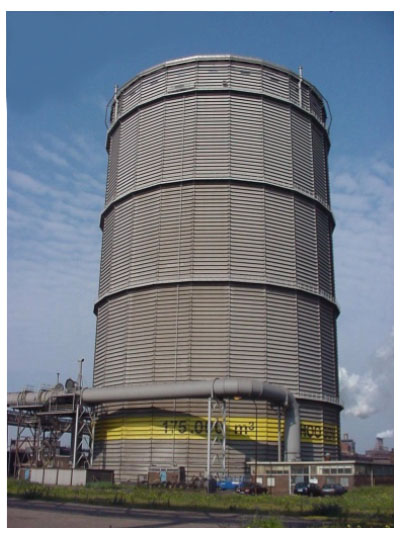-
What are the applications of Blast Furnace Gas (BFG)?
Date posted:
-
-
Post Author
dev@edge.studio
1. Introduction
The typical fuel gases used in integrated iron and steelworks are listed in CF62 and introduced in more detail in CF100. This group of industrial fuel gases includes [GLOSS]Blast Furnace Gas[/GLOSS] or [GLOSS]BFG[/GLOSS].
Blast Furnace Gas BFG is produced as a by-product from pig iron production in [GLOSS]blast furnaces[/GLOSS]. Pig iron, or “[GLOSS]hot metal[/GLOSS]” is a base material for steel production in a basic oxygen furnace or electric arc furnace.
Blast Furnace Gas is a low [GLOSS]calorific value[/GLOSS] fuel gas, which can be used as gaseous fuel in various applications inside or outside the iron making plant. A significant amount of Blast Furnace Gas is used for the production of hot blast in blast furnace stoves.
The production, fuel properties and combustion and flue gas properties of BFG are described in associated Combustion File numbers 218, 242 and 243 respectively. The present CF concentrates applications of BFG.
2. Storage and distribution
Cleaned Blast Furnace Gas is ready to be used as fuel in several applications. Therefore it must be stored and distributed. This is normally done by gasholders and pipelines. In Figure 1 the Blast Furnace Gas holder of Corus IJmuiden is shown.

Figure 1 Blast Furnace Gas Holder of Corus IJmuiden
The IJmuiden gasholder may contain up to 175.000 cubic meters of gas at a pressure up to 60 mbar. The gasholder acts to smooth out short-term differences between the rate of supply from the blast furnace and the rate of use, and gas composition differences in time are smoothed out. It also helps by providing a constant supply pressure for gas distribution [2].
To transport the Blast Furnace Gas from the gasholder to the consumers, a distribution net via pipelines is necessary. Since Blast Furnace Gas is normally saturated with water vapour, drip legs need to be installed in the piping system to remove water. This, together with the required maintenance of the fuel lines (i.e. regular inspection, mechanical and chemical cleaning), makes the fuel lines very expensive.
3. Applications
Due to the high amount of inert species (N2, CO2 and H2O), Blast Furnace Gas is a low calorific value fuel gas. Therefore, the [GLOSS]adiabatic flame temperature[/GLOSS] is relatively low and it is not suitable for high temperature processes, such as in [GLOSS]reheating furnace[/GLOSS]s, unless it is mixed with a [GLOSS]higher calorific value[/GLOSS] fuel gas,such as Natural Gas or Coke Oven Gas, to enhance and control the calorific value, Wobbe index or adiabatic flame temperature. Other benefication options are discussed in linked CF249.
Unenriched Blast Furnace Gas is well suited to be used in blast furnace stoves and power plants (boilers and gas turbines).
4. Health and Safety Considerations
Blast Furnace Gas is a toxic gas since it contains large amounts of carbon monoxide.
Inhaling large amounts of Blast Furnace Gas directly causes dizziness followed by falling into a faint and eventually causes death.
Long term inhaling of small amounts of this gas is detrimental for the unborn child [5].
Sources
[1] American Iron and Steel Institute, www.steel.org
[2] Ricketts, J.A., How a blast furnace works, Ispat Inland Inc.
[3] N.V. Nederlandse Gasunie, Physical properties of natural gases, Groningen, Netherlands, 1980.
[4] Zabetakis, M.G., Flammability characteristics of combustible gases and vapors, Bulletin 627, Bureau of Mines, 1965.
[5] Informatie Chemische Stoffen, werkinstructiekaart oxygas, Corus, 2002.
